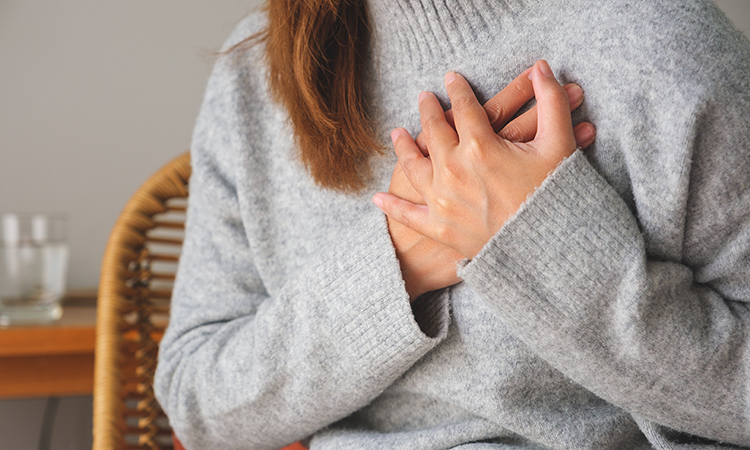
Breast pain, or mastalgia, is a common symptom that brings many women to their healthcare providers. In this article, we will discuss the different types of breast pain, the possible causes, and the available treatment options.
Types of Breast Pain
- Cyclic breast pain: This is the most common type of breast pain, occurring in both breasts a few days before the onset of menstruation. The pain can become more severe and extend throughout the menstrual cycle. Although there are some simple treatments that are helpful, for many women, cyclic breast pain becomes a major problem. Fortunately, for the vast majority of these women, the pain seems to improve with time, no matter what the treatment.
- Non-cyclic breast pain: Women commonly experience pain in one breast that seems unrelated to the menstrual cycle and is not related to other obvious causes such as trauma or pregnancy. The pains can occur anywhere in either breast but often start in the nipple and radiate to the armpit. Such pains are quite common and are probably of neurogenic origin. This type of jolting pain does not respond well to treatment, but it usually resolves on its own. If pain persists for more than two months, medical attention is indicated.
- Focal breast pain: Other breast pains are more focal and persistent. If the pain is aggravated by movement, it is probably of musculoskeletal origin, and treatment with over-the-counter analgesics is indicated. Again, if the pain persists for more than two months, medical attention is indicated.
Possible Causes of Breast Pain
- Hormonal fluctuations: Hormonal fluctuations during the menstrual cycle are the most common cause of breast pain.
- Fibrocystic breast changes: Breast pain can also be associated with fibrocystic breast changes, which are benign changes in the breast tissue.
- Breast infections: Breast infections, such as mastitis, can cause breast pain, along with redness and swelling.
- Trauma:Trauma to the breast, such as a blow to the chest or a fall, can also cause breast pain.
- Breast cancer: While breast pain is rarely the first symptom of breast cancer, in rare cases, it can be a sign of cancer. When breast cancer is associated with pain, the pain tends to be focal, i.e., in one spot in the breast. The pain also tends to get steadily worse over time.
Treatment Options:
Caffeine restriction:
Reducing or eliminating caffeine intake can result in significant reductions in cyclic breast pain in some women. Caffeine is found not only in coffee but also in tea, most soft drinks, and chocolate. Women with low-to-moderate intake of caffeine may have a less predictable response to caffeine restriction. It is recommended that women with cyclic breast pain reduce or eliminate caffeine intake to experience at least partial relief of symptoms. There is no known relationship between caffeine intake and an increased risk of breast cancer.
Evening Primrose oil (EPO):
EPO is a natural supplement that comes in a capsule form, and some women report significant benefits with its use. It is recommended that a patient starts with 1,500 mg twice a day for at least two weeks. If there is improvement in pain, this dosing is continued for at least 3 months to assess its effect over successive menstrual cycles and can be continued as needed for symptomatic relief. If no benefit is obtained, dosing can be discontinued.
Vitamin E and other “antioxidants”:
Vitamin E and some B vitamins have been credited with providing relief for breast pain. However, the data to support their effectiveness in women with breast pain is limited.
Estrogen and Breast Pain:
One of the most common side effects of estrogen is breast pain, and post-menopausal women on estrogen may experience breast pain. It is recommended that all post-menopausal women on estrogen take the lowest dose that will control menopausal symptoms. This can also help reduce breast pain associated with estrogen intake.
Diet and Breast Pain:
A low-fat diet may have some benefit in reducing breast pain. Women are still recommended to follow a low-fat diet, as it may help in lowering breast cancer risks and is definitely of value in lowering cardiac risks and the risk of other types of cancer. The American Heart Association Diet is a good resource for women looking for dietary guidance.
Breast Support:
Wearing a well-fitted bra can help reduce breast pain. It is important to get a good fit, and professional fitters can be of assistance. In some cases, extra support can be obtained with an additional external wrap, such as with a circumferentially wrapped ace-bandage.
Iodine Replacement:
There are reports that iodine can reduce breast pain. Some women have reported benefits with over-the-counter iodine-containing products. However, further research is needed to confirm these reports, and no specific product can be recommended at this time.
Other Products:
Bromocriptine and danazol are medications that can be used for severe breast pain. However, the side effects of both drugs can be significant, and patients should discuss the risks and benefits of these medications with their healthcare provider. Diuretics have been advised in the past, but they are not recommended for breast pain. Over-the-counter analgesics such as Tylenol, aspirin, and non-steroidal anti-inflammatories (i.e. Advil, Motrin) can provide short-term pain relief.
Surgery:
In the past, subcutaneous mastectomy was used as a treatment for extreme breast pain that was not responsive to standard treatments. However, this operation is no longer commonly performed, and less invasive forms of treatment are now available.
In conclusion, breast pain is a common condition that can be treated with several options ranging from dietary changes to medication. Women with breast pain are advised to consult with their physician.

